How To Freeze Strawberries
This post may contain affiliate links. Read disclosure policy.
Learn how to freeze strawberries the easy way with this easy step-by-step guide. Don’t miss out on saving and using those super sweet seasonal strawberries. Follow our tips and tricks for the best results.

The big hurrah for strawberry season is starting to slow down (depending on where you live in the country). Most farms around here plant berries that ripen late spring/early summer, but you may still be able to find them all summer long if the farm has some ever-bearing plants.
Strawberry picking (well, pretty much all fruit picking) is a family favorite around these parts. Really, it is mostly me with the weird obsession, but my older kids happily (usually) comply knowing that they will get a benefit of eating a belly full of strawberries.
Every year we add some more strawberry plants to our patch, and allow the runners to dig their roots in, but if there is anything to learn about parenting, it is that you can never plant enough berries to satisfy your children. And I mean never. One million plants… not enough. They will engorge themselves in those juicy berries until they have juice running down their faces looking like vampires.
But wouldn’t it be nice to enjoy the ripe, juiciness of sweet strawberries all year round? The good news is that with proper preparation, you can!
Today, I want to show you how to freeze strawberries for maximum freshness, so you can enjoy them in smoothies, desserts, and more.
From selecting the best strawberries to thawing them properly, we’ll cover everything you need to know. So get ready to stock up on those red gems and learn how to preserve their flavor and texture for later use!
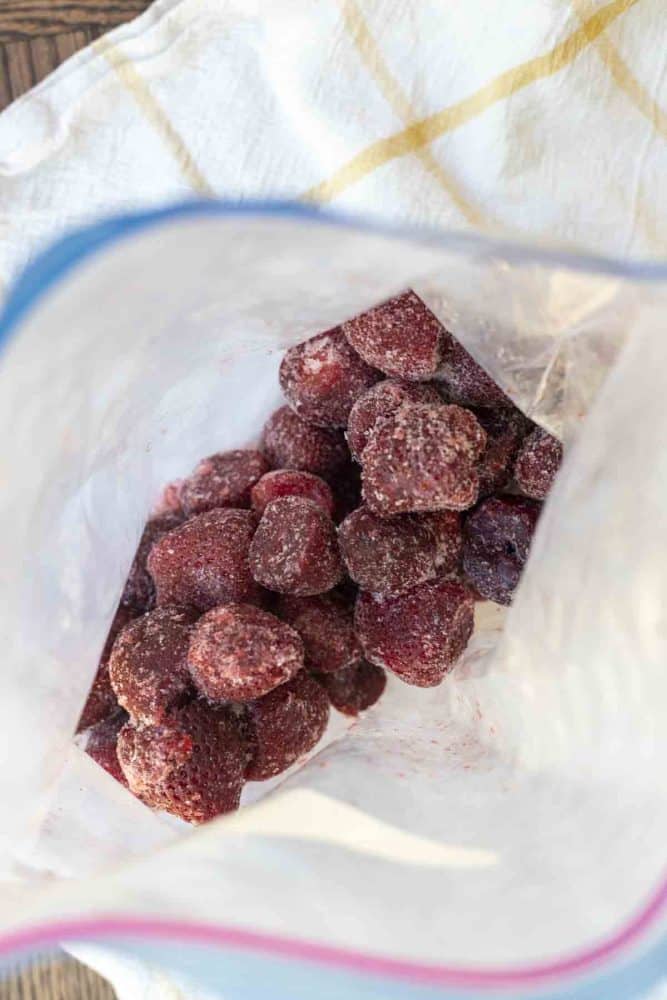
Why you will love freezing strawberries
Enjoy all year around: A wonderful way to enjoy fresh strawberries frozen at the peak of ripeness when they are so juicy and full of flavor during the cold winter months. Yes please!
Convenience: I love having frozen fruit on hand whenever you want it. No more last-minute trips to the grocery store for overpriced berries that are likely past their prime. With a stock of frozen strawberries in your freezer, you can quickly whip up a smoothie, make a parfait, or add them to your morning yogurt without any hassle.
Reduce food waste: We’ve all been there – buying too many strawberries only to let them go bad before we can use them all. By freezing them, you can extend their life and prevent them from ending up in the compost bin.
Versatile: Frozen berries are also great for baking, so if you have a surplus of berries, you can easily make a pie, cobbler, or muffins without any waste. You can also use them to make smoothies, popsicles, syrups, and just snack on them (which I do almost every single night).
Tips
- Use strawberries that are at their peak for freshness and ripeness. Avoid ones that are mushy or overly ripe, as they may not hold up as well when frozen.
- Wash your strawberries thoroughly and remove the stems and any green leaves. Allow them to dry completely before cutting them.
- For best results, freeze your strawberries as soon as possible after purchasing or harvesting. This will help lock in their flavor and texture.
- Consider freezing a variety of berries: sliced, chopped and whole strawberries. This gives you a variety of options for smoothies and baking.
- Use a freezer-safe container or bag to store your frozen strawberries. Make sure to label the container with the date and contents, so you can keep track of how long they’ve been frozen.
The links in this post contain affiliate links and I will receive a small commission if you make a purchase after clicking on my link. See the full disclosure here.
Where to buy Strawberries in bulk:
- Farmer’s market
- Local farms
- U-pick farms
- Growing them yourself
- Grocery store- Sometimes you can find them on super sale.
Tools you may need:
Parchment paper or wax paper
Freezer containers: You can use plastic freezer bags or plastic containers (I know people who reuse cleaned lunch mean containers). Glass containers would also work
Cutting board
Paring knife
Selecting the Best Strawberries
To ensure maximum freshness in your frozen strawberries, it’s important to start with the best berries possible. Look for strawberries that are ripe, but not overripe . They should be firm and bright red with no signs of bruising or soft spots. You can also freeze berries that are slightly overly ripe. The texture may not be super great after they thaw, but they sure are sweet.
If possible, opt for locally grown strawberries that aren’t sprayed. These will typically have the best flavor and texture. Strawberries are often one of the most sprayed produce, and since you eat the skin, it is better to find berries that aren’t sprayed.
If you’re buying from a grocery store, give the strawberries a sniff. They should smell sweet and fragrant. If they have no smell or smell sour, they’re probably not the best choice.
Selecting the best strawberries before freezing will ensure that you end up with deliciously sweet and flavorful fruit once they’re thawed.
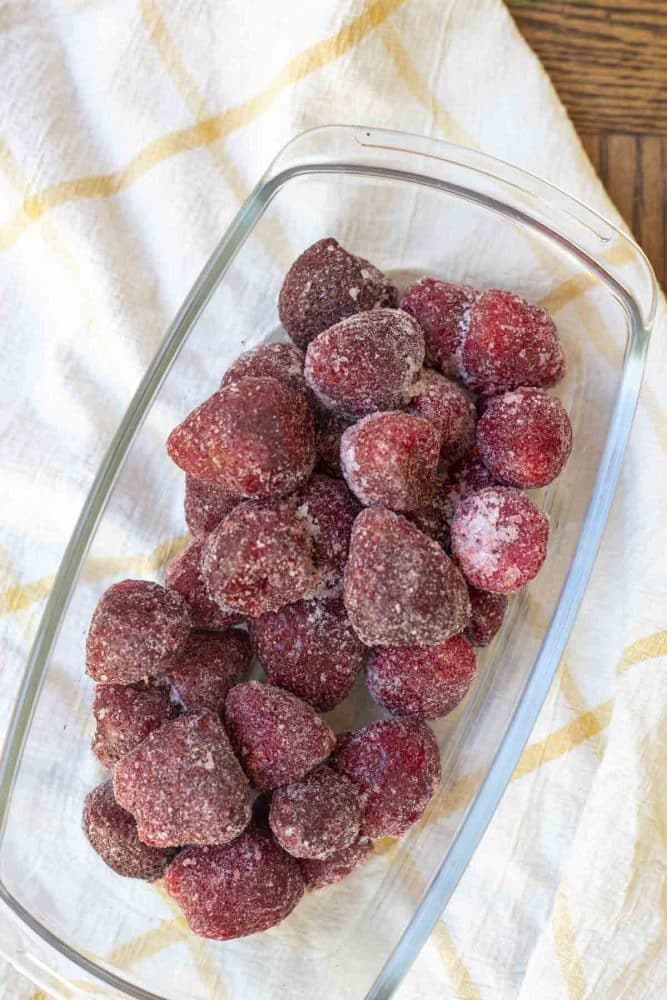
How To Freeze Strawberries

Step 1: Wash Strawberries:
First, rinse the berries in cold water. To clean strawberries, I like to soak them in a vinegar water mixture (3 parts water to 1 part white vinegar) for a few minutes in a large bowl before straining them.

Strain and then rinse with cold water.

Step 2: Dry
Gently place the strawberries onto a clean kitchen towel or paper towels and separate, to allow the air to circulate better.

Allow to air dry until completely dry. This will help prevent ice crystals.
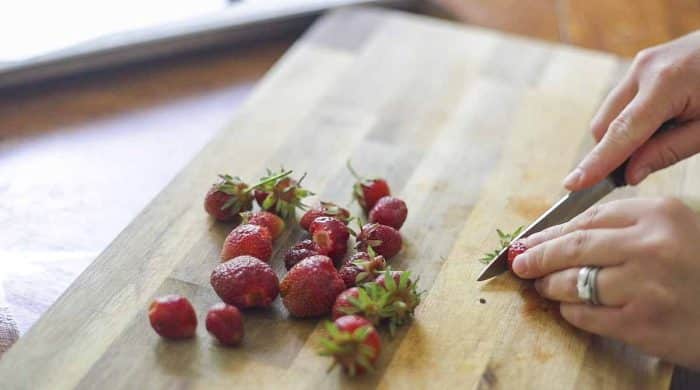
Step 3: Slice And Place On A Baking Sheet
Remove the green tops and any bruised or damaged areas. Slice if desired.
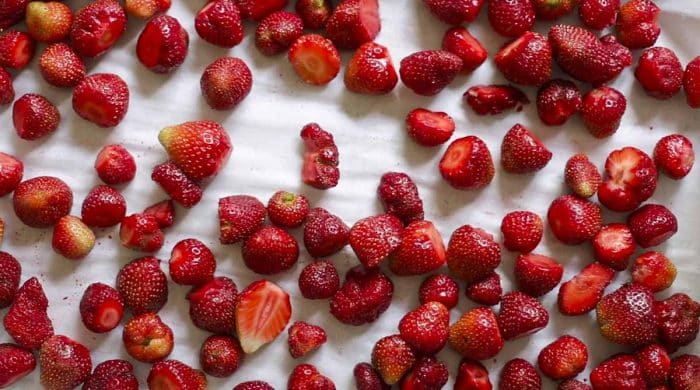
Lay whole berries and/or sliced berries out on a baking sheet lined with parchment paper. Make sure the strawberries are not touching each other, as this will cause them to freeze together in big clumps.
Save This Recipe

Step 4: Freeze
Place the baking sheet in the freezer and let the strawberries freeze for at least two hours, or until they are completely frozen.

Step 5: Transfer For Long Term Storage
Once frozen, transfer the strawberries to a freezer-safe container or bag, making sure to remove as much air as possible.
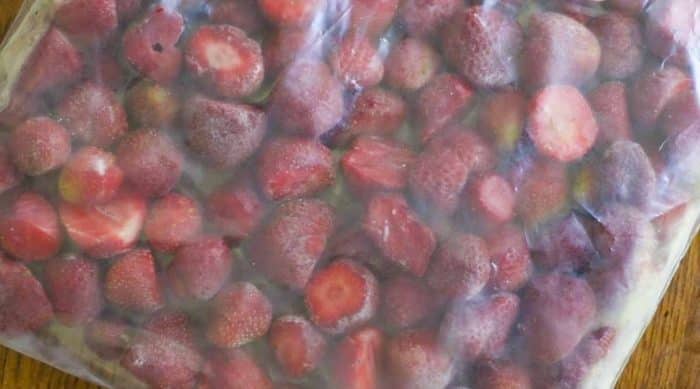
Label the container with the date and contents, so you can keep track of how long they’ve been frozen.
Freezing Techniques for Maximum Freshness
Once your strawberries are prepped and ready to go, it’s time to move on to the different freezing techniques that will help ensure maximum freshness.
Option 1: The Preferred Way
Freeze the strawberries on a baking sheet before transferring them to a freezer-safe container. This method allows the strawberries to freeze individually, which prevents them from clumping together. Simply spread the strawberries out in a single layer on a baking sheet and place them in the freezer for a few hours until they’re frozen solid. Once they’re frozen, transfer them to a freezer-safe container and they’re ready to go.
Option 2: The “Lazy” Way
I will oven just follow the instruction, but rather than pre-freezing on a baking sheet, I will place them in the freezer bag, about half full. Close it up and remove extra air. Then lay it flat in one layer and freeze flat. You will get more ice crystals, but it takes less time and can get more done quicker.
Option 3: In Syrup
Another option is to pack the strawberries tightly into a freezer-safe container and cover them with a sugar syrup. The sugar syrup will help protect the strawberries texture and flavor during the freezing process, and it will also help prevent freezer burn.
To make the syrup, mix together equal parts sugar and water in a saucepan and heat until the sugar is dissolved. Let the syrup cool before pouring it over the strawberries and sealing the container.
No matter which freezing technique you choose, be sure to label the container with the date and contents. This will help you keep track of how long the strawberries have been frozen and ensure that you use them before they start to lose flavor and texture.
Tips For Storing Your Frozen Strawberries
Once your strawberries are frozen and labeled, it’s time to figure out the best way to store them.
- Keep in mind that strawberries will start to lose quality after about six months, so it’s best to use them within that time frame.
- To extend their shelf life, store the strawberries in a freezer that maintains a consistent temperature of 0°F or lower.
- Avoid storing them in the door of the freezer, as the temperature can fluctuate and cause freezer burn. Instead, store them in the middle or back of the freezer, where the temperature is more stable.
Thawing Your Strawberries
When it comes time to use your frozen strawberries, it’s important to thaw them properly to preserve their flavor and texture. The best method is to transfer them from the freezer to the fridge and allow them to thaw overnight. This slow thawing process helps retain their sweetness and firmness, although they will not be the same.
If you need to use your strawberries more quickly, you can also thaw them at room temperature for a few hours or by placing them in a sealed plastic bag and submerging them in cold water. However, these methods may result in slightly softer berries.
Avoid thawing your strawberries in the microwave as it can cause them to become mushy and lose their flavor.
Once your strawberries are thawed, store them in the refrigerator and be sure to use them within a day or two for optimal freshness.
Now that you know how to thaw your frozen strawberries, let’s get creative with some tasty recipes!

Different Ways to Use Your Frozen Strawberries
Before you start experimenting with frozen strawberries in your recipes, it’s important to note that the texture of the berries may change slightly after freezing. For example, they may become slightly softer and less firm. However, this shouldn’t impact the taste of your dishes.
- Strawberry smoothie: Or really any smoothie
- Yogurt
- Baked goods: Another delicious option is to use them in baked goods like crisps, muffins, cakes, quick breads, and pies.
- Savory: If you’re feeling adventurous, try using frozen strawberries in savory dishes like salads or as a topping for grilled meats.
- Drinks: Add a unique flavor to cocktails and other beverages. The possibilities are truly endless!
- Popsicles
- Ice cream
- Strawberry jam and preserves: One of the best tips I ever learned was that you can use frozen fruit (or vegetables) for canning. So if you are just so busy during harvest time to can some recipes. Many things can be made with frozen fruit.
- Strawberry shortcakes
- Strawberry sauce
- Overnight oats

FAQ
Can I freeze strawberries with the stems still on?
Yes, you can. However, it’s easier to remove the green stems before freezing as it saves you time when you’re ready to use them.
Can I freeze strawberries without sugar?
Yes. Freeze whole or sliced strawberries without sugar. It won’t affect their texture or freeze-ability. Adding sugar to the strawberries before freezing enhances their flavor and helps maintain their color, but it is not required or needed.
Can I freeze strawberries in plastic bags?
Yes. Ziplock bags work well for freezing strawberries. However, make sure to press out as much air as possible before sealing the bag to prevent freezer burn.
How long can I keep frozen strawberries?
Frozen strawberries can last up to 1 year in the freezer if properly stored. However, it’s best to use them within 6 months for the best quality.
Can I freeze strawberries that are already cut?
Yes. Just make sure to spread them out in a single layer on a baking sheet before freezing so they don’t clump together.
Find More Ways To Preserve The Harvest:
- How To Freeze Blueberries
- How To Freeze Zucchini
- Homemade Refrigerator Dill Pickles
- Blueberry Chia Jam
- How to Freeze Kale – 2 Easy Ways
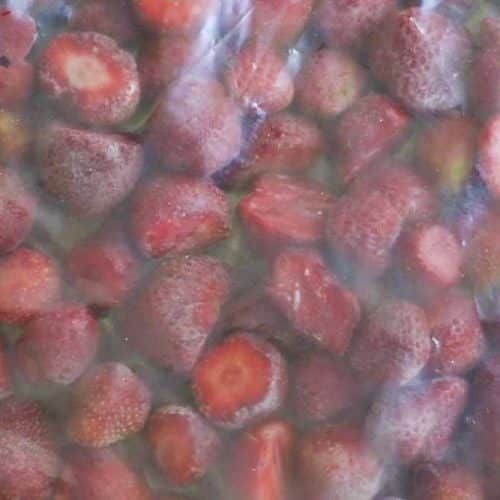
How To Freeze Strawberries
Save This Recipe
Equipment
- Cutting board
- Knife
- Freezer safe container
Ingredients
- 1-10 lbs strawberries
Instructions
- Clean strawberries: I like to soak them in a vinegar water mixture (3 parts water to 1 part white vinegar) for a few minutes in a large bowl before straining them. Strain and then rinse with cold water.
- Gently place the strawberries onto a clean kitchen towel or paper towels and separate to allow the air to circulate better. Allow to air dry until completely dry.
- Remove the green tops and any bruised or damaged areas. Slice if desired.
- Lay whole berries and/or sliced berries out on a baking sheet lined with parchment paper. Make sure the strawberries are not touching each other.
- Place the baking sheet in the freezer and let the strawberries freeze for at least two hours, or until they are completely frozen.
- Once frozen, transfer the strawberries to a freezer-safe container or bag, making sure to remove as much air as possible.
- Label the container with the date and contents. Place back into the freezer.
Notes
- Use strawberries that are at their peak freshness and ripeness. A
- Allow them to dry completely before cutting them.
- For best results, freeze your strawberries as soon as possible after purchasing or harvesting. This will help lock in their flavor and texture.
- Consider freezing a variety of berries: sliced, chopped and whole strawberries. This gives you a variety of options for smoothies and baking.
- Use a freezer-safe container or bag to store your frozen strawberries.

